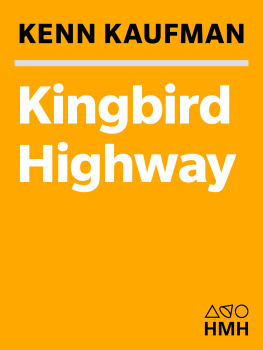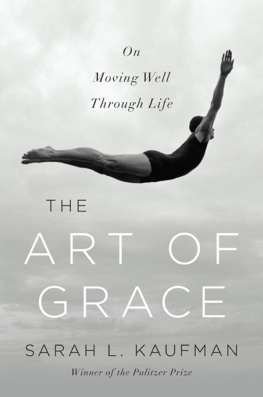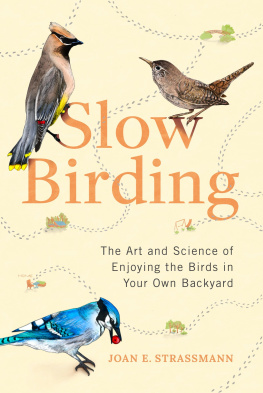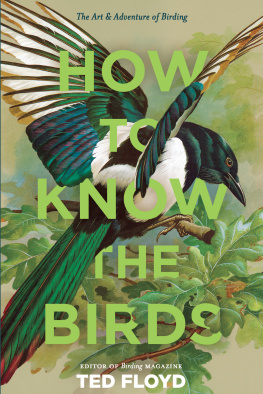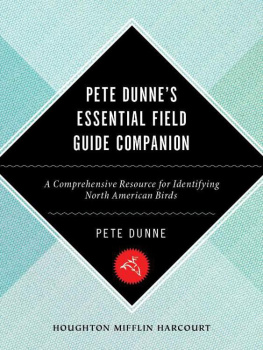First Houghton Mifflin paperback edition 2006
Text and illustrations copyright 1997 by Kenn Kaufman
Afterword copyright 2006 by Kenn Kaufman
All rights reserved.
For information about permission to reproduce selections from this book, write to Permissions, Houghton Mifflin Harcourt Publishing Company, 215 Park Avenue South, New York, New York 10003.
www.hmhco.com
The Library of Congress has cataloged the print edition as follows:
Kaufman, Kenn.
Kingbird highway : the story of a natural obsession that got a little out of hand / Kenn Kaufman.
p. cm.
ISBN 0-395-77398-9
1. Bird watchingUnited StatesAnecdotes. 2. Bird watchingMexicoAnecdotes. 3. Adventure and adventurersUnited StatesBiography. 4. Adventure and adventurersMexicoBiography. 5. Kaufman, KennJourneysUnited States. 6. Kaufman, KennJourneysMexico. 7. United StatesDescription and travel. 8. MexicoDescription and travel. I. Title.
QL 682. K 38 1997
598.0723473dc21 97-581 CIP
ISBN -13: 978-0-618-70940-3 (pbk.)
ISBN -10: 0-618-70940-1 (pbk.)
e ISBN 978-0-547-34944-2
v3.1114
DEDICATED TO THE MEMORY OF
THEODORE A. PARKER III
19531993
Ted Parker was not destined to slow down, ever.
He was like a runaway train,
except that he was running on tracks that
he had planned out for himself, and he knew
exactly where he was going.
Editors Note: Capitalizing of Birds Names
B ECAUSE so many kinds of birds are mentioned in this book, we have followed standard scientific practice of capitalizing the names of species. Ornithologists and serious birders find that such capitalizing brings clarity in discussing the nearly 10,000 species of birds in the world. For example, there are dozens of kinds of blue jays around the globe, but the Blue Jay is a particular species that lives mainly in eastern North America. Any trogon might be described as elegant, but the Elegant Trogon is a specific type. In a similar vein, we can write of western ducks and mean all the ducks of the West, but the capitalization of Western Tanager signals that we are discussing one particular species. Readers who are unfamiliar with birding may find all these capital letters jarring at first, but we hope that they will be able to glide over them smoothly after a few chapters.
Preface
P EOPLE always called us birdwatchers. But if we had been, there would be no story to tell.
Nothing could have been simpler than birdwatching. An activity by that name would have required nothing more than one person, alone, watching birds, any birds. The birds rarely would have watched the person in return: perfectly independent, birds had no reason to care about humans. So the watching would have been one-way, and the matter would have ended there, with no ramifications.
But in the early 1970s, we were not birdwatching. We were birding, and that made all the difference. We were out to seek, to discover, to chase, to learn, to find as many different kinds of birds as possibleand, in friendly competition, to try to find more of them than the next birder. We became a community of birders, with the complications that human societies always have; and although it was the birds that had brought us together, our story became a human story after all.
People have always looked at birds, but the hobby and sport of birding really developed in the twentieth century. It developed gradually, for the most part, with only a few landmark events, like the invention (in the 1930s) of the modern field guide for recognizing birds. But there was one brief period when birding went through revolutionary changes. Improvements in communication and in travel made it possible for people to seek birds from coast to coast, and birding changed from a mild local pastime to a continent-wide craze. It is only now, looking back from a distance of two decades, that we can see how far-reaching and thorough the changes were. Birding for the 1990sindeed, birding for the twenty-first centurywas born in the brief period from 1970 to 1975.
This is a story about that time. I was fortunate enough to be traveling throughout North America, in pursuit of birds, during that formative era. It was a good time to be on the road, a good time to be very young, a good time to learn and travel and grow while we played this great new game called birding.
Not Quite the West
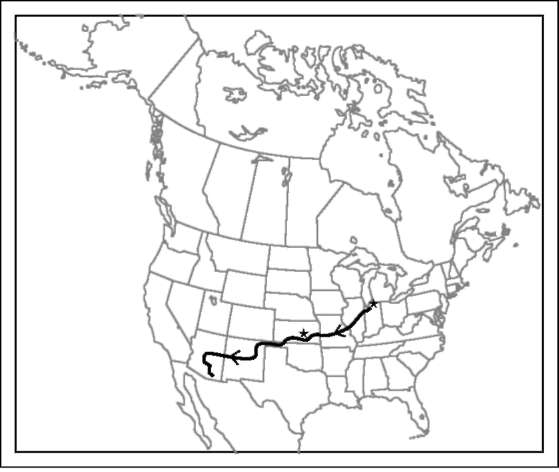
I WENT OUT on the road, to chase my dream, at the age of nine.
That was what I used to tell the girls I met while I was bumming rides around North America in the 1970s; and, of course, they didnt believe me any more than you do. But the truth is that the seeds for all my later travels were planted on my ninth birthday. That was the day the family moved, the day the last thing was packed and we drove away from the house in Indiana for the last time.
That days drive still comes to mind with surprising clarity: the tree-lined streets of South Bend falling away behind us, the country opening up, the Illinois state line coming up as a milestone to be remarked upon. My father pointing things out and explaining things: the construction of the bridges, the uses of the farm machinery, the history behind the Land of Lincoln signs. My mother, so good with words, making up little poems and word games to amuse the kids in the back seat.
Always the quiet and introverted one, I was quieter than usual that day, sitting in the back and staring out the window. My parents noticed and said once again they were sorry we had had to move on my birthday. But they need not have worried. Already a rebel in the quietest way, I had decided for myself that holidays or special days meant nothing if they were dictated by the calendar. Any day might be a special oneyou just had to get outside and see if it was.
This was an incredibly special day because of where we were: out on the highway, with the tires drumming hypnotically on the pavement, and with new possibilities everywhere just beyond the wide horizon. That day I was first aware of feeling a significant difference from my parents and my brothers. They were thinking about our destination, mostly, or about the place we were leaving behind. I was focused on the road itself, on the feeling of going somewhere, anywhere, just going. As the sun moved down the western sky directly ahead of us, it seemed to draw us along. A crazy sense came over me that we should just follow the sun and keep pace with it, around and around the earth, and the day would never end.
And as long as the day was unending I would be staring out the car windows with all the intensity of a nine-year-old boy, scanning the fences, the wires, the open fields, the distant treetops, and the sky, because I had a purpose, a mission, a passion: I was watching for birds.
A curiosity about natureor about picture books on naturehad come to me out of nowhere in earliest childhood. By the time I was six, having concluded that there were no tigers or comets or dinosaurs in our humdrum Indiana neighborhood, I had turned to birds as the best thing available. After that I had never looked back. My interest became a driving force, fueled by books from the local branch library, encouraged by parents who promoted any genuine learning and so had refused for years to have a television in the house.
The other boys in my neighborhood idolized baseball players or movie cowboys, but my hero was the great bird expert, Roger Tory Peterson. I had checked his books out from the library and read them over and over again. I had studied all of his paintings, especially of the birds I could not find in the South Bend suburbs. When my parents started to talk about moving, my first thought was New birds!
Next page
